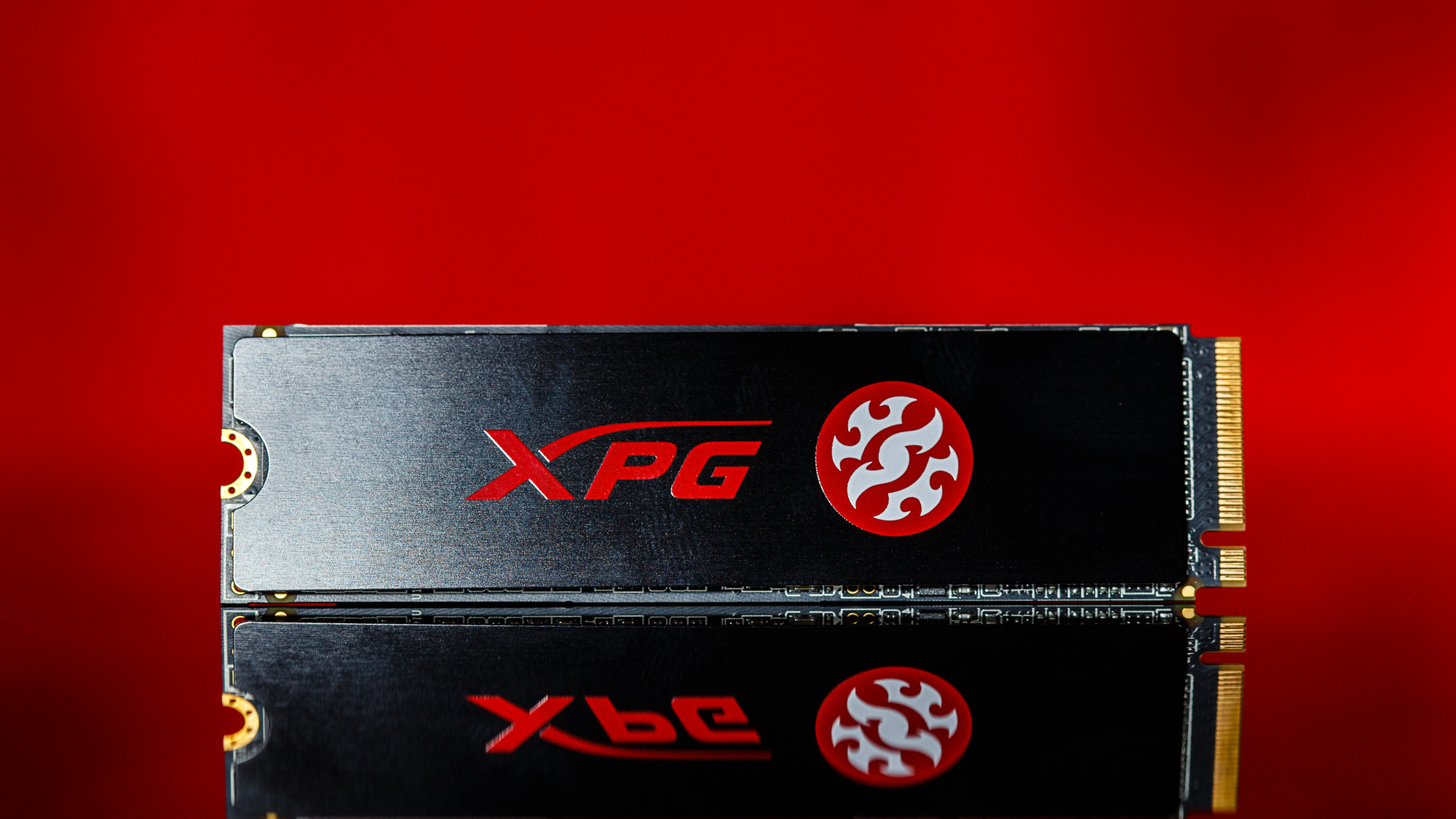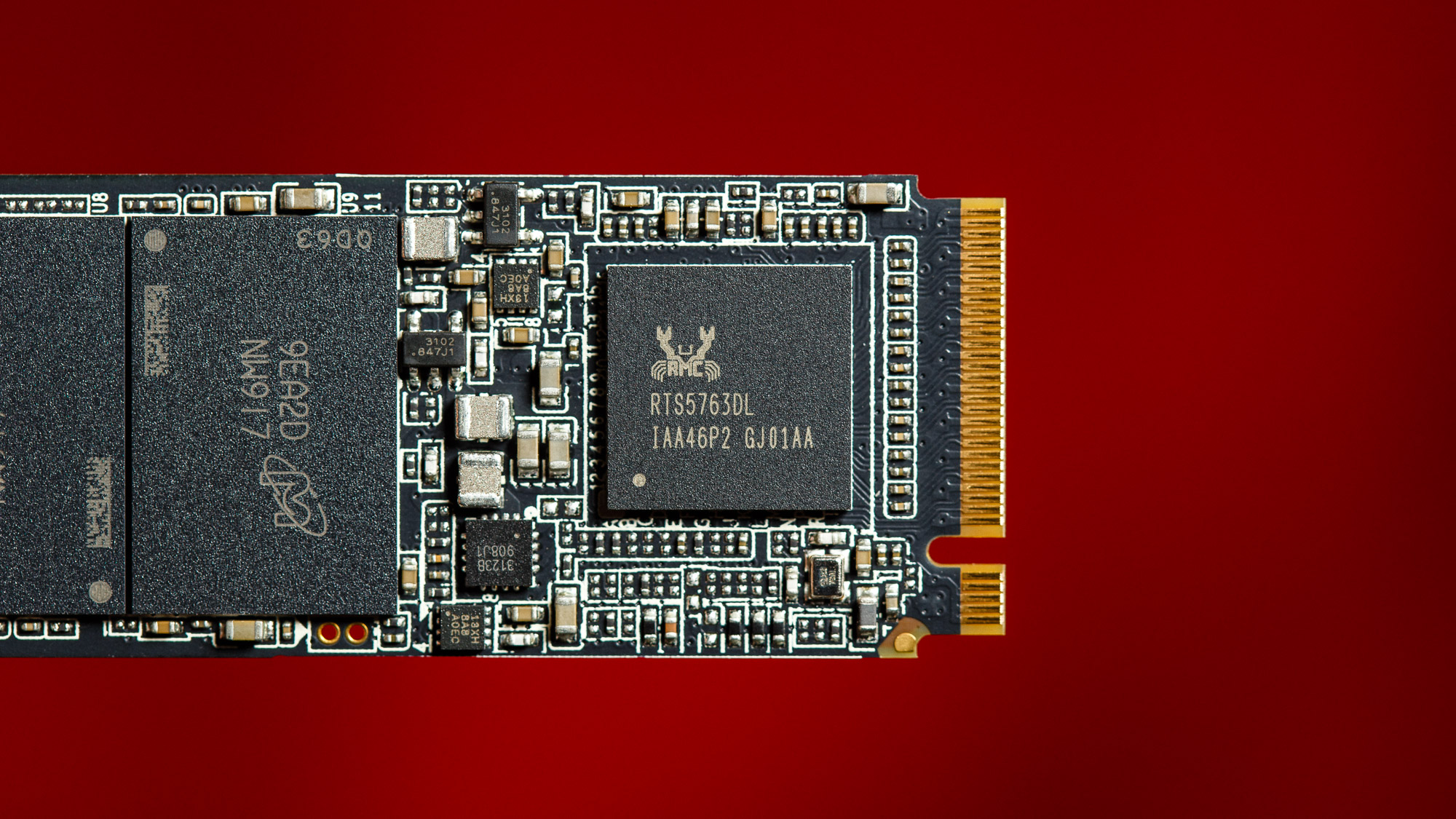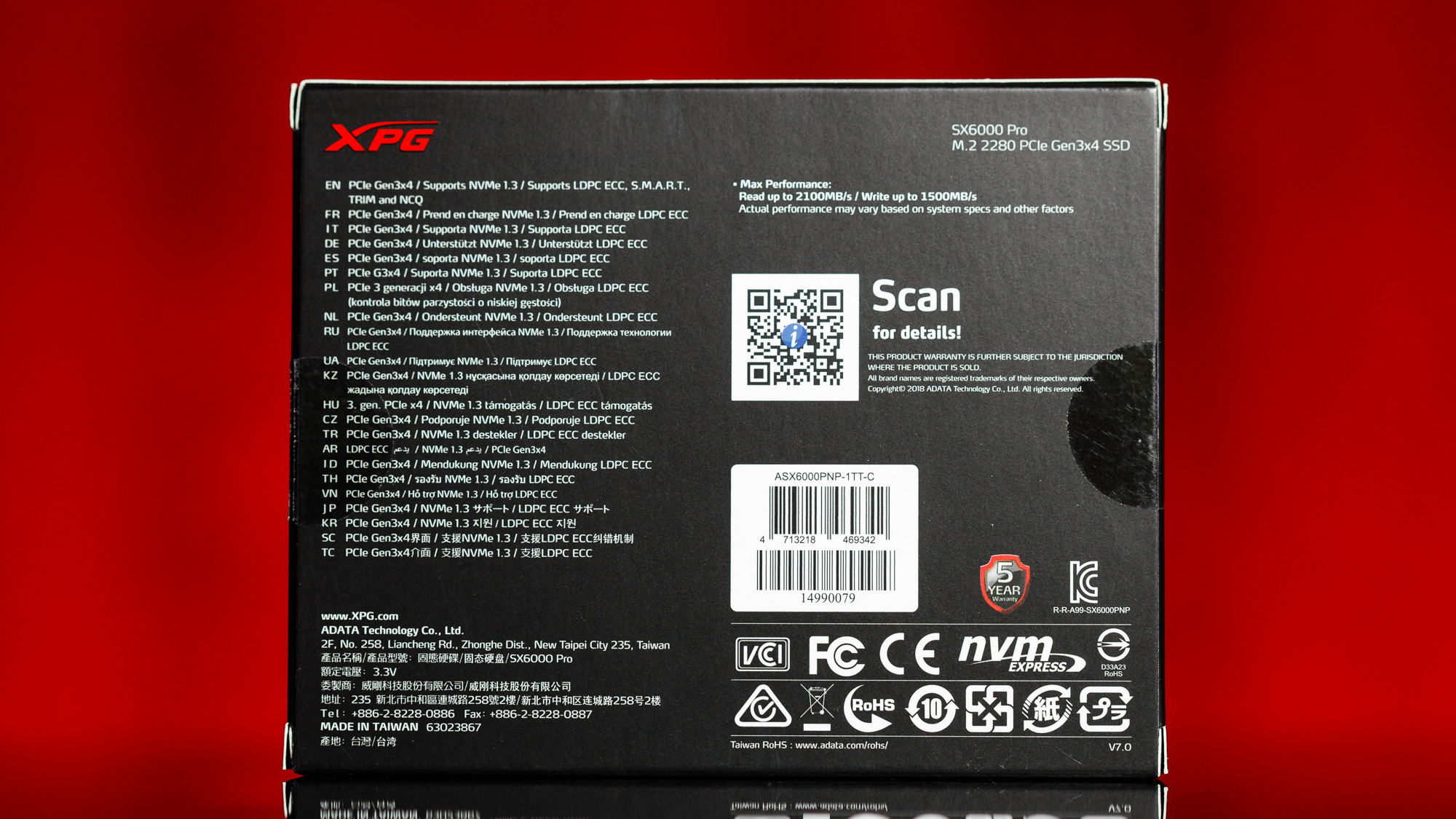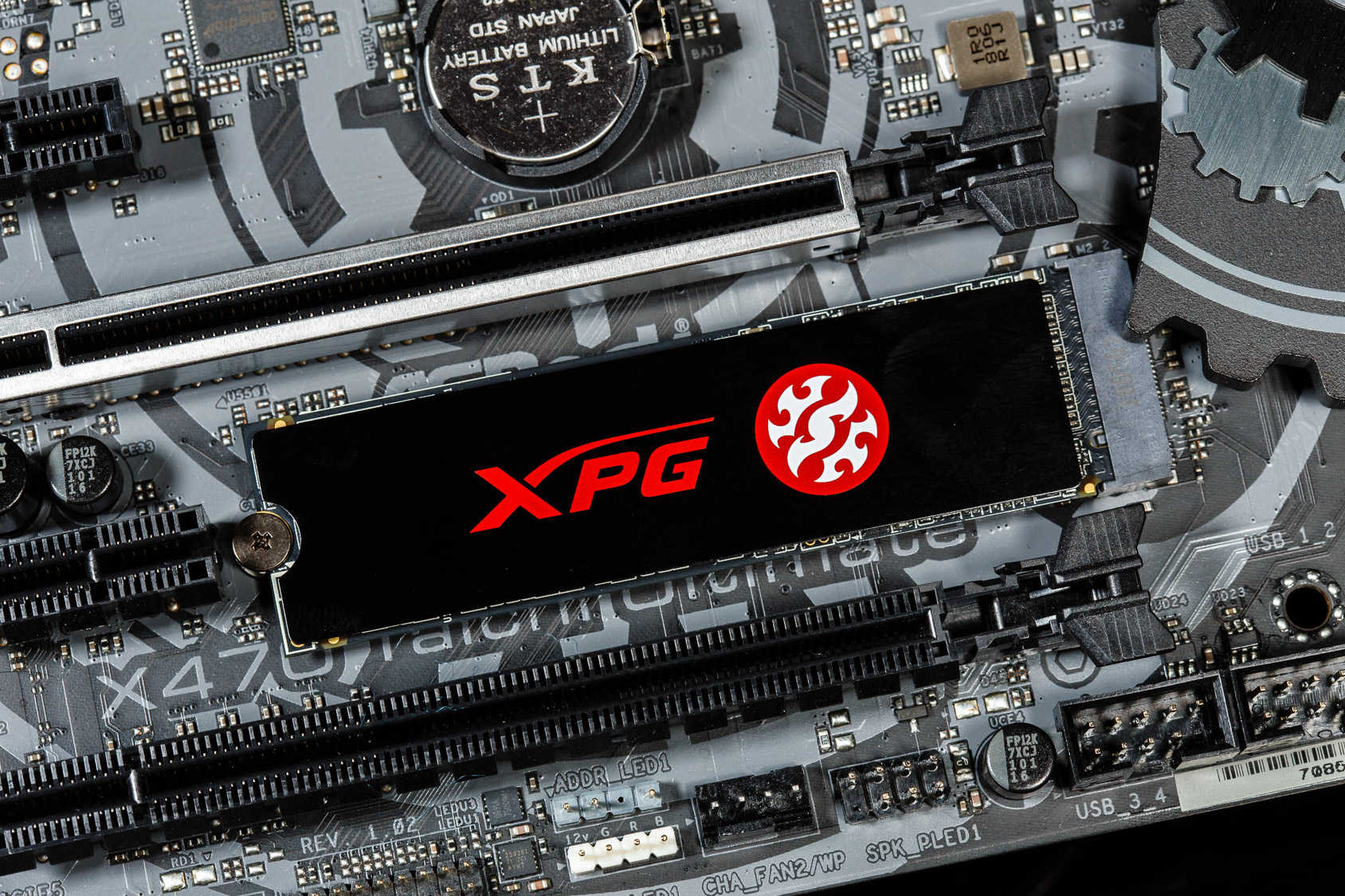Tom's Hardware Verdict
The Adata XPG SX6000 Pro's DRAMless design is meant to cut costs, but it limits performance while competitors offer faster speeds for the same price or less.
Pros
- +
Sleek aesthetics
- +
Large dynamic write cache
- +
Competitive endurance
Cons
- -
Below-average application performance
- -
Poor direct-to-TLC write speed
Why you can trust Tom's Hardware
A Not So Extreme NVMe SSD
Armed with a Realtek NVMe controller and Micron’s 64L TLC flash, Adata’s XPG SX6000 Pro is an entry-level contender ready to take on the SSD market. But, unlike most SSDs, this device is DRAMless and instead, employs the NVMe Host Memory Buffer (HMB) feature to commandeer a few MB of DRAM from the host for the task. While this lowers manufacturing costs, it isn’t optimal for performance. And, with the 1TB SX6000 Pro weighing in at $120, its value isn’t the best.
Dropping DRAM out of the equation completely can sometimes hinder an SSD's performance significantly because flash management processes no longer have a fast cache buffer to retrieve FTL data from; instead everything has to work directly in the controller or on the NAND itself. But the trade-off is that it saves the manufacturer a sizable sum when producing them, a savings that should typically be passed down to the consumer in cheaper, more entry-level devices.
To keep costs down, but improve performance, the NVMe protocol was ratified to include HMB so that the controller can still have some DRAM space to help speed things up. Realtek’s RTS5763DL, the controller powering the SX6000 Pro does just that. It utilizes 64MB of the host’s DRAM to try to maintain acceptable performance under consumer workloads. It even features a rather large dynamic write cache to help mitigate slow direct to TLC write performance too. Although, this also means that, after the cache is full, write performance will degrade until it has ample time to flush the cache.
Specifications
| Product | XPG SX6000 Pro 256GB | XPG SX6000 Pro 512GB | XPG SX6000 Pro 1TB |
| MSRP (U.S.) | $39.99 | $59.99 | $119.99 |
| Capacity (User / Raw) | 256GB / 256GB | 512GB / 512GB | 1024GB / 1024GB |
| Form Factor | M.2 2280 Single-sided | M.2 2280 Single-sided | M.2 2280 Single-sided |
| Interface / Protocol | PCIe 3.0 x4 / NVMe 1.3 | PCIe 3.0 x4 / NVMe 1.3 | PCIe 3.0 x4 / NVMe 1.3 |
| Controller | Realtek RTS5763DL | Realtek RTS5763DL | Realtek RTS5763DL |
| DRAM | N/A, 64MB HMB | N/A, 64MB HMB | N/A, 64MB HMB |
| Memory | Micron 64-Layer TLC | Micron 64-Layer TLC | Micron 64-Layer TLC |
| Sequential Read | 2,100 MB/s | 2,100 MB/s | 2,100 MB/s |
| Sequential Write | 1,200 MB/s | 1,500 MB/s | 1,500 MB/s |
| Random Read | 190,000 IOPS | 250,000 IOPS | 250,000 IOPS |
| Random Write | 180,000 IOPS | 240,000 IOPS | 240,000 IOPS |
| Encryption | N/A | N/A | N/A |
| Endurance | 150 TBW | 300 TBW | 600 TBW |
| Part Number | ASX6000PNP-256GT-C | ASX6000PNP-512GT-C | ASX6000PNP-1TT-C |
| Warranty | 5-Years | 5-Years | 5-Years |
This SSD interfaces with the host via a PCIe 3.0 x4 link and communicates via the NVMe 1.3 protocol and initial specs look promising. It can hit up to 2.1 / 1.5 GBps read/write speeds under sequential workloads and its random 4K performance can hit upwards of 250,000 / 240,000 IOPS read/write. Not too shabby for a new kid on the block. But we will have to wait and see how that actually translates to real-world performance when we put it to the test.
Endurance figures are pretty good too, matching most other SSDs in the market. Our 1TB model is rated to write up to 600 terabytes before its 5-year warranty gets voided. Additionally, it offers standard features such as S.M.A.R.T. data reporting, Trim, and support for the Format NVM / secure erase command. It also has LDPC ECC, end-to-end data path protection, and boasts a RAID engine built in to maintain data integrity.
Software and Accessories
Included with the SSD itself is an optional black, metal heat spreader that has thermal tape pre-applied. As well, ADATA provides a download for Acronis True image HD, a disk migration utility, and an SSD toolbox to manage the SSD, from their website.
A Closer Look
The XPG SX6000 Pro is an M.2 2280 form factor SSD that features a single-sided PCB design, meaning that there are components on only one side of it. Aesthetically, the SSD is appealing as the brushed metal heat spreader adds a slice of style that many competitors lack.
Get Tom's Hardware's best news and in-depth reviews, straight to your inbox.







Underneath the optional heat spreader lies the heart of the device, the Realtek RTS5763DL. This controller is a DRAMless solution from the company that is paired with four of Micron’s 64L TLC NAND flash packages on the 1TB model, the one we reviewed.
MORE: Best SSDs
MORE: How We Test HDDs And SSDs
MORE: Best External Hard Drives and SSDs

Sean is a Contributing Editor at Tom’s Hardware US, covering storage hardware.
-
refillable I got one of these because it was $10 cheaper than the 660p. I think I still got a decent deal to be frank. It all depends on the price.Reply -
Giroro Pros: "Large SLC write cache "Reply
later:
"Unlike most SSDs we have tested, the SX6000 Pro doesn’t feature an SLC write cache, but rather an MLC write cache, or so it appears. "
Overall this drive seems like a poorly balanced design. Especially considering the SX8200 Pro is only $135 on Amazon right now. -
skinnedballs Hello Sean! Thanks for the review.Reply
I wonder if your SX6000 Pro was a dud or if some other issue was present. Chris Ramseyer reviewed the drive several months back at Tweak Town and had a much better experience, especially where sustained sequential performance was concerned:
https://www.tweaktown.com/reviews/9064/adata-xpg-sx6000-pro-nvme-ssd-review/index2.html -
tlmiller76 I had both a Crucial P1 and this drive (Crucial came in my laptop, bought the SX6000 pro), and having swapped them between the laptops they were in to compare (Dell Latitude 7490 and Dell Latitude 5289), I was far more impressed with the performance of the SX6000 pro than I ever was with the P1. While I haven't had a 660, given the P1 is identical other than firmware, and the sx6000 pro is usually the same price or a few dollars less every time I look for a new drive, I'd take this any day over a 660.Reply -
gadgetwhisperer Replytlmiller76 said:I had both a Crucial P1 and this drive (Crucial came in my laptop, bought the SX6000 pro), and having swapped them between the laptops they were in to compare (Dell Latitude 7490 and Dell Latitude 5289), I was far more impressed with the performance of the SX6000 pro than I ever was with the P1. While I haven't had a 660, given the P1 is identical other than firmware, and the sx6000 pro is usually the same price or a few dollars less every time I look for a new drive, I'd take this any day over a 660.
well, P1 is using QLC just like intel 660p, but it also have DRAM. in my experience, the problem of adata xpg sx6000 pro is when they decide to switch from silicon motion controller to realtek. realtek have less experience and thats why the consistency is quite rough. i already bought dozen of xpg ssd to upgrade my customers notebook, most of earlier version of sx6000 pro still used silicon motion controller, and performance was better (or at least more consistent), then came the sx6000 lite with realtek controller. months later all pro model were also switched to realtek one. The price go lower, but the write performance take a toll. In windows notebook, it still perform well, since the HMB seems to work just fine, but on macbook pro, the write performamce is stuck around 500Mb/s (on par with SATA SSD).
in my experience, at this price point, Lexar with it NM610 offer the best value and performance. 2nd option is Patriot P300 with its phison controller. Adata used to be good, but their decision to use realtek is kinda backfiring, at least at this moment. Maybe firmware upgrade can help them, but who knows